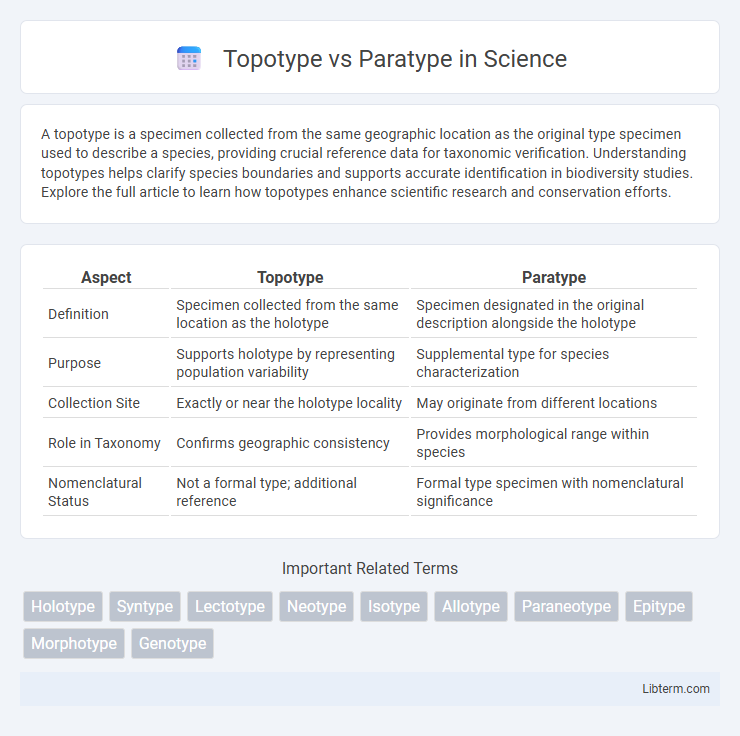A topotype is a specimen collected from the same geographic location as the original type specimen used to describe a species, providing crucial reference data for taxonomic verification. Understanding topotypes helps clarify species boundaries and supports accurate identification in biodiversity studies. Explore the full article to learn how topotypes enhance scientific research and conservation efforts.
Table of Comparison
| Aspect | Topotype | Paratype |
|---|---|---|
| Definition | Specimen collected from the same location as the holotype | Specimen designated in the original description alongside the holotype |
| Purpose | Supports holotype by representing population variability | Supplemental type for species characterization |
| Collection Site | Exactly or near the holotype locality | May originate from different locations |
| Role in Taxonomy | Confirms geographic consistency | Provides morphological range within species |
| Nomenclatural Status | Not a formal type; additional reference | Formal type specimen with nomenclatural significance |
Introduction to Topotype and Paratype
Topotypes are specimens collected from the same geographical locality as the holotype, serving as important references for verifying species identity and variations. Paratypes are additional specimens cited in the original description of a species that complement the holotype and provide insight into the species' variability. Both topotypes and paratypes play crucial roles in taxonomic research by supporting accurate species identification and classification.
Defining Topotype
Topotype refers to a specimen collected from the same locality as the holotype, serving as a reference for verifying species identity and morphological variation. It holds taxonomic significance by representing individuals from the original type locality, helping to confirm species characteristics within that geographic area. Paratype denotes additional specimens cited in the original species description but collected from different localities or different individuals that support the holotype's species diagnosis.
Defining Paratype
A paratype is a specimen cited in the original description of a species that, along with the holotype, helps define the variability within that species but is not the primary reference specimen. Unlike topotypes, which are specimens collected from the same locality as the type specimen, paratypes may originate from different locations yet still support the species' characteristics. Defining paratypes clarifies the range of morphological features and ensures a comprehensive understanding of the species beyond the holotype.
Key Differences Between Topotype and Paratype
Topotype refers to a specimen collected from the exact location where the original type specimen, or holotype, was found, serving as a geographic reference for species identification. Paratype, on the other hand, includes additional specimens cited in the original species description but from different locations or individuals, providing morphological variation. The key difference lies in their origin and function: topotypes confirm the locality-specific traits of a species, while paratypes illustrate intraspecific variability.
Importance of Topotypes in Taxonomy
Topotypes are specimens collected from the exact location as the type specimen and play a critical role in taxonomy by providing additional reference material that helps confirm species identity and variation within the original population. Paratypes serve as supplementary specimens used alongside the holotype to aid in describing the species, but topotypes have the unique advantage of representing the same geographic and ecological context, ensuring greater accuracy in taxonomic comparisons. The importance of topotypes lies in supporting taxonomic revisions, validating species boundaries, and enhancing the reliability of biodiversity assessments.
Role of Paratypes in Species Identification
Paratypes serve as supplementary specimens in species identification, providing additional reference points to the holotype by representing variation within the species. Unlike the holotype, which is the single specimen designated as the name-bearing type, paratypes help clarify the species' morphological range and aid taxonomists in confirming identification. Their role is crucial in ensuring a comprehensive and accurate description of new species by encompassing diversity beyond the holotype's characteristics.
Collection and Designation of Types
Topotypes are specimens collected from the exact location as the original type specimen, often used to supplement the type series without being formally designated as types. Paratypes are specimens cited in the original description alongside the holotype, serving as reference material to demonstrate variation within the species. Both topotypes and paratypes play crucial roles in the collection and designation of types by providing critical data that supports taxonomic clarity and stability.
Topotype and Paratype in Zoological Nomenclature
Topotype refers to a specimen collected from the same locality as the holotype, often used to confirm species characteristics and enhance taxonomic accuracy. Paratype is any specimen from the type series other than the holotype, serving as supplementary reference material in zoological nomenclature. Both topotypes and paratypes provide critical data for species identification, validation, and comparative analysis within taxonomic research.
Common Misconceptions
Topotype and paratype often get confused due to their association with type specimens in taxonomy, yet they serve distinct purposes. A topotype is a specimen collected from the exact location as the holotype, used to confirm the species' characteristics, whereas a paratype is any specimen cited in the original species description that is not the holotype. Misconceptions arise when topotypes are mistakenly treated as paratypes or vice versa, leading to errors in taxonomic verification and biological research.
Conclusion: Choosing Between Topotype and Paratype
Topotypes provide critical locality-specific reference for species descriptions by representing specimens from the original type locality, ensuring precise geographic context. Paratypes, while diverse in origin, offer valuable morphological variation supporting the species concept beyond the topotype's limited range. Selecting between topotype and paratype depends on the need for geographic accuracy versus capturing broader intraspecific variation in taxonomic studies.
Topotype Infographic

 libterm.com
libterm.com